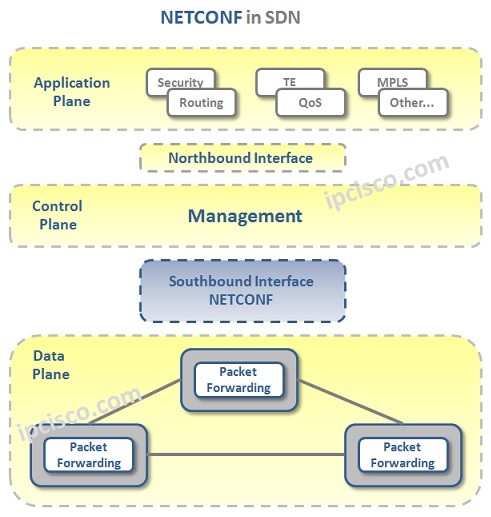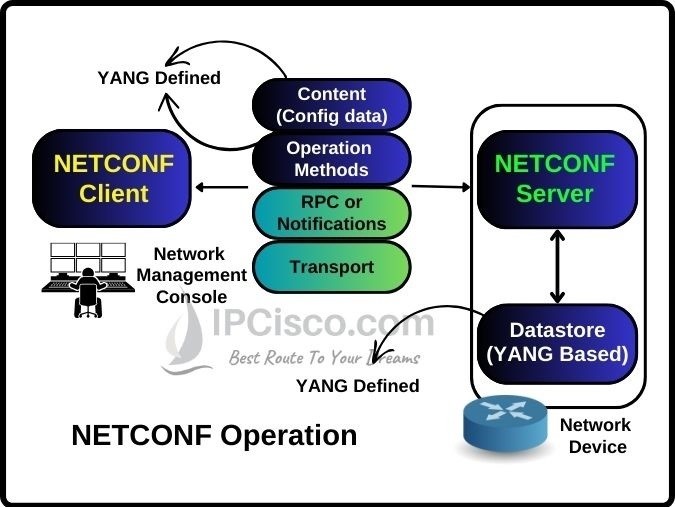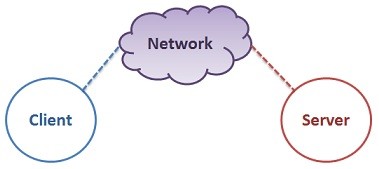- COURSES
- SPECIALS
- BLOG
- MEMBERS
- SHOP
- ABOUT
- ENROLL HERE

Table of Contents
NETCONF Protocol (Network Configuration Protocol) is a standard based IETF Network Configuration Management Protocol. It is also a network automation and programmability protocol. With this Network Configuration Management Protocol, we can install, modify and remove the configuration of the network devices. It is explained in RFC 6241. There is also another network automation and programmability protocol for network configuration management, it is explained in the lesson of RESTCONF Protocol.
NETCONF runs over SSH and it uses port 830. It also uses XML data format (Extensible Markup Language) for data exchange.
Network Configuration Protocol is a Network Management protocol like SNMP (Simple Network Management Protocol). But NETCONF is a better protocol than SNMP for Network Management.

NETCONF Operation
NETCONF Protocol is used in the Southbound Interface of SDN. As we have talked about before, Southbound Interface is the SDN interface that connects the Forwarding Plane and the Control Plane.

Basically, NETCONF Architecture is consist of two main elements. These elements are:

The NETCONF Server provides the exchange of NETCONF messages. A software on the network device does this.
Network Configuration Protocol uses Remote Procedure Calls (RPCs) with YANG Model to facilitate the communication between client and server.

Network Configuration Protocol is a session-based protocol. For operation, firstly, a session must be established between the client and the server. Here, NETCONF Server has a passive role in this operation. It waits for NETCONF Client to initiate the session. Here, the process steps are like below:
There are many benefits of using Network Configuration Protocol as a network configuration protocol. These benefits are given below:
First of all, NETCONF is a standard based network configuration protocol that we can use for many network devices produced by different vendors.
Configurations are more structured and readable with this new configuration technology.
Network Configuration Protocol runs over secure transport layers like SSH. This ensures that management traffic is encrypted and secure from unauthorized access.
NETCONF is a session-based protocol. It allows stateful sessions that keep track of multiple operations, providing context for the ongoing management operations.
NETCONF works closely with the YANG (Yet Another Next Generation) data modeling language. This provides standardized configuration data models, making it easier to automate and manage the configuration of devices across different platforms.
It supports a range of management operations like get, edit, copy configurations.
It is an enhanced automation tool because it leverages its structured data models and transactional nature. By using this technology, it is easy to integrate with modern orchestration tools and simplifies tasks like bulk configuration changes or large-scale network automation.
NETCONF differentiates between configuration data (the desired state) and state data (the actual operational state), which simplifies auditing and troubleshooting.
Network Configuration Protocol provides detailed error reporting, easy debugging and troubleshooting for configurations. With this mentality, for example, you can also find the failure part in the configuration.
It is scalable. With NETCONF, we can manage both small networks and large networks with thousands of devices.
Network Configuration Protocol can send notifications about changes to the configuration or operational state of devices, enabling real-time monitoring and faster response to issues.
Taking all things into account, NETCONF protocol simplifies network configuration and management by offering a standardized, secure, and automated way to manage network devices. Its integration with YANG and support for modern automation frameworks makes it ideal for evolving network environments.
Network Configuration Protocol uses port 830 by default. It works over SSH.
NETCONF is a standard based protocol. It is IETF standard and it is explained in RFC 6241.
SSH is used as transport component in Network Configuration Protocol. It provides the security between NETCONF client and the NETCONF server. So NETCONF is a secure protocol.
Leave a Reply